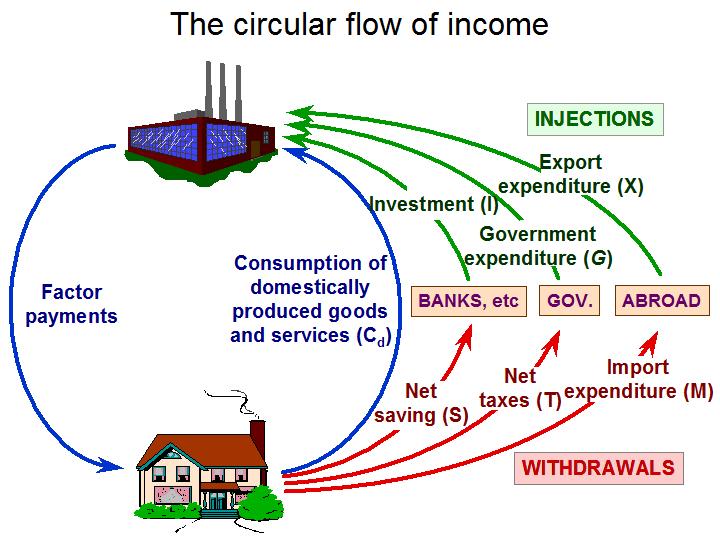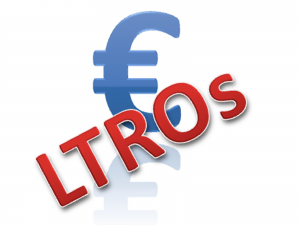 At the Mansion House dinner on 15 June, the Chancellor, George Osborne, and the Governor of the Bank of England, Sir Mervyn King, announced a new monetary policy initiative to increase bank credit. The idea is to stimulate borrowing by both firms and households and thereby boost aggregate demand.
At the Mansion House dinner on 15 June, the Chancellor, George Osborne, and the Governor of the Bank of England, Sir Mervyn King, announced a new monetary policy initiative to increase bank credit. The idea is to stimulate borrowing by both firms and households and thereby boost aggregate demand.
There are two parts to the new measures:
1. Funding for lending. The aim here is to provide banks with cheap loans (i.e. at below market rates) on condition that they are used to fund lending to firms and households. Some £80 billion of loans, with a maturity of 3 to 4 years, could be made available to banks under the scheme. The details are still being worked out, but the scheme could work by the Bank of England supplying Treasury bills to the banks in return for less secure assets. The banks could then borrow against these bills in the market in order to lend to customers.
2. Providing extra liquidity to banks through six-month repos. The Bank of England will begin pumping up to £5bn a month into the banking system to improve their liquidity. This is an activation of the ‘Extended Collateral Term Repo Facility’ (see also), which was created last December, to provide six-month liquidity to banks against a wide range of collateral.
 But whilst it is generally accepted that a lack of borrowing by firms and households is contributing to the slowdown of the UK economy, it is not clear how the new measures will solve the problem.
But whilst it is generally accepted that a lack of borrowing by firms and households is contributing to the slowdown of the UK economy, it is not clear how the new measures will solve the problem.
In terms of the supply of credit, banks have become more cautious about lending because of the increased risks associated with both the slowdown in the UK economy and the euro crisis. They claim that the issue is not one of a shortage of funding for lending, but of current uncertainties. They are thus likely to remain reluctant to lend, despite the prospect of extra loans from the Bank of England.
In terms of the demand for credit, both businesses and consumers remain cautious about borrowing. Even if bank loans are available, firms may not want to invest given the current uncertainties about the UK, eurozone and world economies. Consumers too may be reluctant to borrow more when people’s jobs may be at stake or at least when there is little prospect of increased wages. Even if banks were willing to lend more, you cannot force people to borrow.
Britain fights euro zone threat with credit boost Reuters, Matt Falloon and Sven Egenter (14/6/12)
Debt crisis: emergency action revealed to tackle ‘worst crisis since second world war’ Guardian, Larry Elliott, Jill Treanor and Ian Traynor (14/6/12)
Q&A: Funding for lending scheme Financial Times, Norma Cohen (15/6/12)
Bank lending plan: How will it work? BBC News (15/6/12)
Bank of England’s loans to high street banks start next week Guardian, Phillip Inman (15/6/12)
 Mervyn King: Bank of England and Treasury to work together The Telegraph (15/6/12)
Mervyn King: Bank of England and Treasury to work together The Telegraph (15/6/12)
 Bank of England offers £80bn loans Channel 4 News, Sarah Smith (15/6/12)
Bank of England offers £80bn loans Channel 4 News, Sarah Smith (15/6/12)
Bank funding scheme plans unveiled Independent, Holly Williams (15/6/12)
Banking: King hits panic button Independent, Ben Chu (15/6/12)
Bankers raise doubts on credit scheme Financial Times, Patrick Jenkins and Sharlene Goff (15/6/12)
We should not pin our hopes on Britain’s plan A-plus Financial Times, Martin Wolf (15/6/12)
Throwing money at banks won’t solve economic crisis, Ed Balls says Guardian, Patrick Wintour (15/6/12)
UK lending plan faces risk of low take-up BloombergBusinessweek, Robert Barr (15/6/12)
Will Bank of England’s new lending schemes work? BBC News, Robert Peston (15/6/12)
Bank and Treasury’s plan A-plus for UK BBC News, Stephanie Flanders (15/6/12)
Questions
- How would the schemes incentivise banks to lend more?
- Explain what is meant by the Extended Collateral Term Repo Facility. How similar is it to the long-term repo operations of the ECB (see the news item More bank debt to ease bank debt)?
- What factors are likely to determine the take-up of loans from banks?
- Will the new arrangements have any implications for taxpayers? Explain.
- To what extent are fiscal and monetary policy currently complementary?
- What is the significance of calling the new measures ‘Plan A-plus’? What would ‘Plan B’ be?
 The press is buzzing with talk of Greece leaving the euro. And if Greece leaves, what next? The press is also buzzing with talk of a possible, if not probable, breakup of the euro altogether – a Eurodämmerung as Paul Krugman calls it.
The press is buzzing with talk of Greece leaving the euro. And if Greece leaves, what next? The press is also buzzing with talk of a possible, if not probable, breakup of the euro altogether – a Eurodämmerung as Paul Krugman calls it.
So is Greece likely to leave the euro, or will the Greek electorate vote next time for the parties supporting the austerity package they negotiated with the EU?
If Greece does leave the euro, what would be the implications for the Greek economy? And what would be the implications for the rest of the eurozone? Would it fall apart: would there a be a domino effect to Spain, Portugal, Italy and Ireland and then the whole eurozone? Or would Germany and the ECB do whatever was necessary to prevent any more countries leaving?
The following articles ponder these weighty questions. In the meantime, stock markets around the world have plunged on fears of the damage a disorderly Greek exit could do to the eurozone and to the global economy.
Greece, euro exit and the drummer in the band Reuters, Luke Baker (14/5/12)
Greek fire could singe rest of euro Financial Times, Richard Milne and Patrick Jenkins (14/5/12)
Eurozone: If Greece goes … Financial Times, Chris Giles, Peter Spiegel and Kerin Hope (13/5/12)
How would Greece leave the euro? BBC News, Kabir Chibber (10/5/12)
 CBI: Greece eurozone exit ‘would be like an earthquake happening’ The Telegraph, John Cridland (14/5/12)
CBI: Greece eurozone exit ‘would be like an earthquake happening’ The Telegraph, John Cridland (14/5/12)
Forget what you’re hearing: Greece won’t quit euro soon Globe and Mail (Canada), Brian Milner (14/5/12)
Could the euro survive a Greek exit? BBC News, Robert Peston (14/5/12)
Greekonomics (see also) BBC News, Paul Mason (9/5/12)
This is how the euro ends – not with a whimper but a bang The Telegraph, Jeremy Warner (15/5/12)
EC and ECB working on emergency plans for Greek euro exit, says trade commissioner Karel De Gucht The Telegraph (18/5/12)
Fiddling while Athens burns The Economist (19/5/12)
Exodus, chapter 1 The Economist (19/5/12)
The Greek run The Economist (19/5/12)
Greece will leave the euro. But what then? Independent on Sunday, Hamish McRae (20/5/12)
No quick fix for Euro – maybe a slow one? BBC News, Stephanie Flanders (24/5/12)
Questions
- If Greece left the euro, what would happen to bank deposits in Greek banks?
- What would be the costs and benefits to the Greek economy of a reintroduction of the drachma?
- Why might individuals and companies, if they were able, move their euro deposits out of Spain, Portugal, Ireland and Italy into accounts based in other eurozone countries? What would be the implications of such financial flows?
- What can the ECB do to support the banking systems in vulnerable eurozone countries? Is there any theoretical limit to the amount that the ECB can offer?
- What is the role of the central banks of individual eurozone countries in a transfer of large-scale funds from one eurozone country to another? How does this impact on the receiving country (e.g. Germany)?
 In December 2011, the ECB provided some €489bn to banks in the form of three-year loans at low interest rates (1%) through open-market operations (see Will new ECB repo operations support the eurozone bond market?).
In December 2011, the ECB provided some €489bn to banks in the form of three-year loans at low interest rates (1%) through open-market operations (see Will new ECB repo operations support the eurozone bond market?).
These ‘Longer-term refinancing operations’ or ‘LTROs’ are designed to ease the burden on European banks which have been struggling to persuade markets that they are dealing with their large amounts of toxic debt, some of which is sovereign debt. Indeed, some of the ECB loans have been used to purchase Italian and Spanish bonds, thereby reducing the likelihood that these countries will default on their debts – at least for the timebeing.
On 29 February 2012, the ECB offered another round of LTROs. Some 800 banks borrowed €530bn under the scheme, bringing the total to a little over €1tr. Initially, much of the money has been put back on overnight deposit with the ECB. The hope, however, is that the loans will be used to support increased credit throughout the eurozone and to fund further purchases of sovereign debt.
But will the increased narrow money supply in the eurozone through these open-market operations result in increased broad money and increased spending and growth? The answer to that depends a great deal on confidence: confidence of banks to lend to firms and consumers; confidence of firms and consumers to borrow. The hope is that the extra money supply will not simply see a corresponding reduction in the velocity of circulation.
The following articles consider the likely effects of these longer-term repos on the real economy.
Articles
ECB hands €529bn in emergency loans to European banks Guardian, Heather Stewart (29/2/12)
Q&A: The ECB’s bank funding programme The Telegraph, Angela Monaghan (29/2/12)
Fighting Debt with Debt Forbes, Bob McTeer (5/3/12)
Is ECB’s €1trn cash boost just the tip of the iceberg? Investment Week, Kyle Caldwell, Dan Jones (5/3/12)
Banks deposit record €821bn at ECB Financial Times, Mary Watkins (5/3/12)
Europe economy may see slim gain from supersize funding: poll Reuters, Sumanta Dey (5/3/12)
Who is the ECB helping? BBC News, Stephanie Flanders (29/2/12)
ECB information on OMOs
Open Market Operations ECB
Questions
- Explain how longer-term refinancing operations work.
- What will determine how much of these ECB loans will be lent to companies?
- Explain what is meant by (a) the velocity of circulation; (b) the money multiplier. Why will the size of these two determine the likely success of the ECB’s LTRO programme?
- Why may the ECB’s actions boost market sentiment? Why might they have the opposite effect?
- Explain what is meant by the “continued de-leveraging by banks”. How does this impact on the money multiplier?
The European Central Bank does not provide direct support to eurozone countries by buying new bonds. However, it can give indirect support by helping banks buy such bonds. In a move announced on 8 December, the ECB will increase the maximum term of its ‘longer-term refinancing operations’ (LTROs) from the current 13 months to three years. In other words, it will effectively provide three-year loans to banks by purchasing banks’ assets on a ‘repurchase (repo)’ basis, whereby banks agree to buy back the assets at the end of the three-year term.
The hope is that banks will use these loans (at an annual rate of 1%) to purchase new bonds from countries such as Italy and Spain. If banks are more willing to buy them, this should help reduce the interest rate at which governments are forced to borrow. Banks would benefit from the ‘carry trade’, whereby they borrow at a low interest rate (from the ECB) and lend at a higher rate to governments by buying their bonds.
To encourage banks to take advantage of these new longer-term repos,the ECB announced that the assets it was prepared to purchase would include securitised assets with a rating of single A (the highest rating is AAA). In other words, it would accept assets with a ‘second-best rating’.
But although the scheme would allow banks to make a clear gain from a carry trade, banks may be reluctant to use such loans to increase their holdings of sovereign debt of countries with large debt to GDP ratios, given concerns in the market about the riskiness of such assets.
Articles and podcast
ECB repo extension a fillip for sovereigns Financial News, Matt Turner (15/12/11)
Doubts over ECB move to boost bond sales Financial Times, Tracy Alloway (15/12/11)
ECB Chief Plays Down Hopes for Bigger Bond Purchases Wall Street Journal, Tom Fairless And Margit Feher (15/12/11)
 Eurozone crisis ‘misdiagnosed’ BBC Today Programme, George Magnus (16/12/11) (second part of podcast)
Eurozone crisis ‘misdiagnosed’ BBC Today Programme, George Magnus (16/12/11) (second part of podcast)
Banks snap up €500bn in loans from European Central Bank Guardian. Larry Elliott (22/12/11)
Analysis: ECB cash to give indirect boost via banks Reuters, Natsuko Waki and Steve Slater (22/12/11)
Demand for ECB loans rises to €489bn Financial Times, Tracy Alloway and Ralph Atkins (21/12/11)
 ECB’s rescue of eurozone banks is temporary BBC News, Robert Peston (21/12/11)
ECB’s rescue of eurozone banks is temporary BBC News, Robert Peston (21/12/11)
ECB Press release
ECB announces measures to support bank lending and money market activity ECB (8/12/11)
Questions
- Explain how repos work. What is the difference between repos and reverse repos?
- What is meant by the term ‘carry trade’?
- Why may banks be unwilling to gain from the carry trade possibilities of the ECB’s new 3-year LTROs by using them to fund the purchase of new sovereign bonds? What risks are entailed by their doing so?
- How do these new long-term repo operations differ from quantitative easing? Explain whether or not the effect is likely to be similar
- What are the arguments for and against the ECB engaging in a round of substantial quantitative easing?
 At the Mansion House dinner on 15 June, the Chancellor, George Osborne, and the Governor of the Bank of England, Sir Mervyn King, announced a new monetary policy initiative to increase bank credit. The idea is to stimulate borrowing by both firms and households and thereby boost aggregate demand.
At the Mansion House dinner on 15 June, the Chancellor, George Osborne, and the Governor of the Bank of England, Sir Mervyn King, announced a new monetary policy initiative to increase bank credit. The idea is to stimulate borrowing by both firms and households and thereby boost aggregate demand. But whilst it is generally accepted that a lack of borrowing by firms and households is contributing to the slowdown of the UK economy, it is not clear how the new measures will solve the problem.
But whilst it is generally accepted that a lack of borrowing by firms and households is contributing to the slowdown of the UK economy, it is not clear how the new measures will solve the problem. Mervyn King: Bank of England and Treasury to work together The Telegraph (15/6/12)
Mervyn King: Bank of England and Treasury to work together The Telegraph (15/6/12) Bank of England offers £80bn loans Channel 4 News, Sarah Smith (15/6/12)
Bank of England offers £80bn loans Channel 4 News, Sarah Smith (15/6/12)
